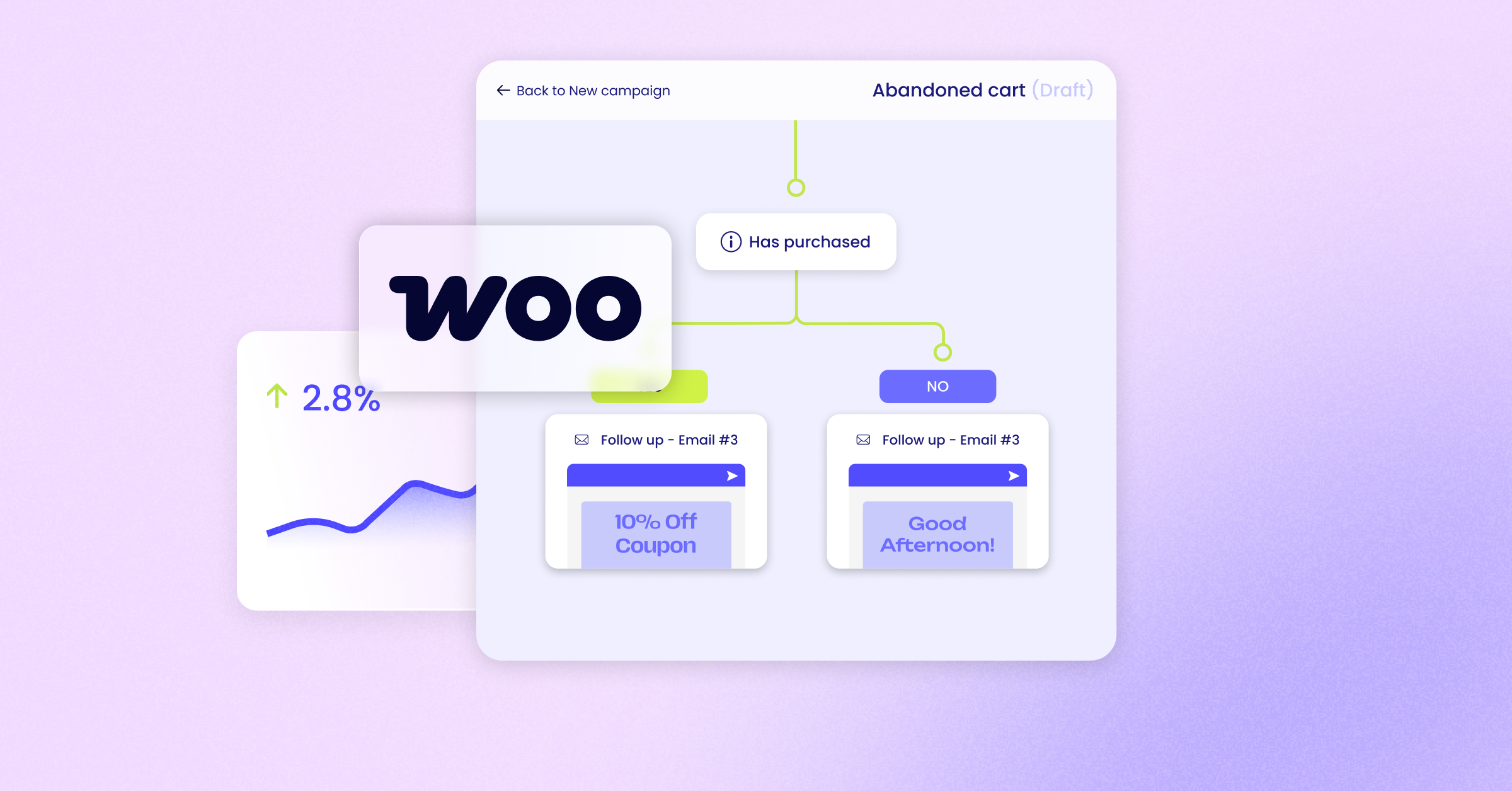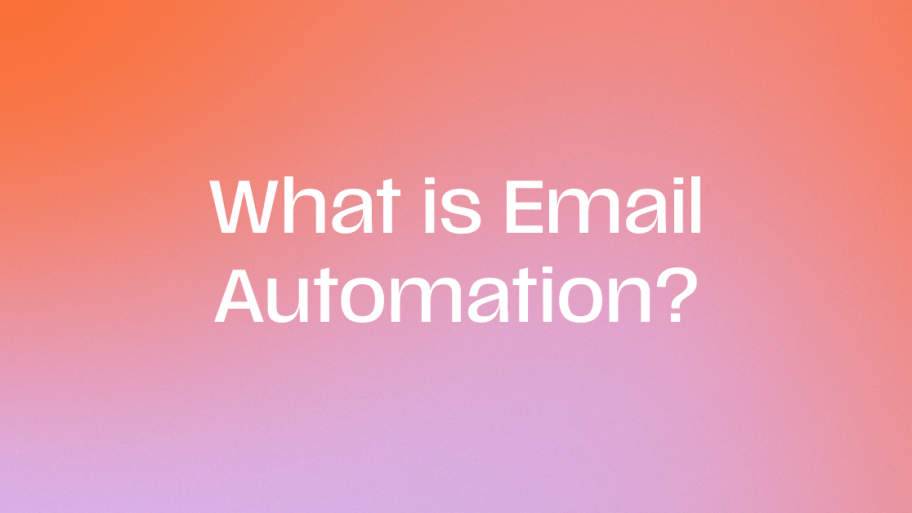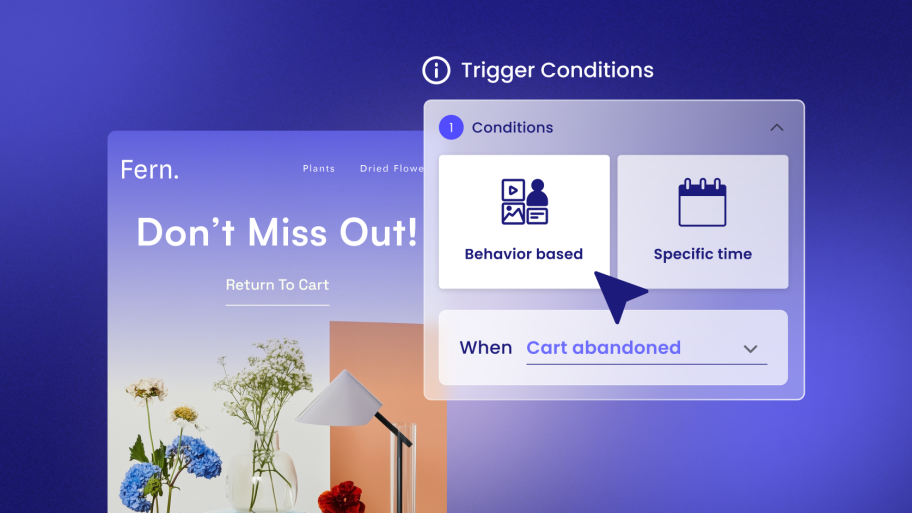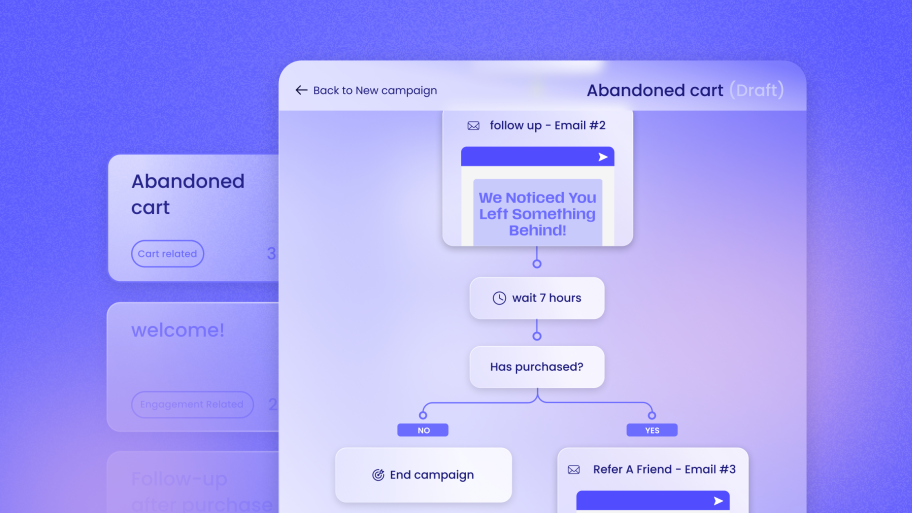Key Takeaways
- Integration is Key: The most effective email marketing solutions are deeply integrated with WordPress and WooCommerce. A native toolkit eliminates plugin conflicts, data syncing issues, and the need for complex API management, offering a smoother, more reliable experience.
- Automation Drives Revenue: Features like abandoned cart recovery, welcome series, and customer win-back campaigns are essential for maximizing sales. Look for plugins that make setting up these automated flows simple and intuitive.
- Beyond Email: Modern communication involves more than just email. Plugins that incorporate SMS marketing provide a powerful, direct channel to engage customers with high open rates, perfect for time-sensitive promotions and alerts.
- Segmentation for Personalization: The ability to segment your audience based on purchase history, browsing behavior, and customer data is crucial for sending relevant, high-impact messages. Generic email blasts are a thing of the past.
- Focus on Business Value: The ultimate goal is to grow your business. The best plugins provide clear, real-time analytics that connect your marketing efforts directly to revenue, helping you understand what works and prove your return on investment (ROI).
- Empowering Creators: For web developers and agencies, choosing a marketing plugin that is easy to manage can create new recurring revenue streams and strengthen client relationships by offering ongoing value beyond the initial website build.
A Deep Dive into the Top WooCommerce Email Marketing Plugins
Choosing the right tool can feel overwhelming. To simplify the process, we’ll explore some of the best options available, starting with a solution designed from the ground up for the WordPress ecosystem.
1. Send by Elementor: The WordPress-Native Communication Toolkit
For businesses and web creators already invested in the WordPress and Elementor ecosystem, Send by Elementor presents a compelling and logical first choice. It’s not just another email marketing service retrofitted for WordPress; it was conceived and built as a native communication toolkit. This fundamental difference addresses the most common pain points—complexity, integration friction, and a fragmented user experience—that plague many third-party solutions.
Send is designed to feel like a natural extension of your WordPress dashboard. It consolidates essential communication channels like email and SMS, powerful automation flows, and deep audience segmentation into a single, cohesive interface. This eliminates the need to juggle multiple platforms, manage clunky API keys, or worry about data synchronization issues between your store and your marketing tool. For a WooCommerce store owner, this means less time spent on technical troubleshooting and more time focused on strategy and growth.
Why a Native Solution Matters
What does “WordPress-native” actually mean for you?
- Seamless Integration: Send works out of the box with WooCommerce and other WordPress components. Customer data, purchase history, and product information are instantly available for segmentation and automation without complex setup. When a customer makes a purchase or abandons a cart, Send knows immediately.
- Familiar User Experience: The interface is designed to be intuitive for anyone who uses WordPress. There’s no steep learning curve or need to learn a completely new platform. You can manage your campaigns, view analytics, and build emails directly from the environment you already know.
- Improved Performance and Security: By operating within WordPress, Send can be optimized for performance, reducing the risk of site slowdowns often associated with external scripts and constant API calls from third-party services.
Core Features that Drive Growth
Send by Elementor is a comprehensive toolkit designed to cover the entire customer lifecycle. Let’s break down its key features and how they translate into tangible business results.
Marketing Automation Flows
This is where Send truly shines. It transforms marketing from a manual, time-consuming task into an automated, revenue-generating system. The platform comes with pre-built automation flows for the most critical e-commerce scenarios, allowing you to get up and running in minutes.
- Abandoned Cart Recovery: This is arguably the most valuable automation for any WooCommerce store. Send can automatically detect when a shopper leaves items in their cart without completing the purchase. You can set up a multi-step email and SMS sequence to remind them, offer a discount, and guide them back to checkout. The setup is remarkably simple, yet the impact on revenue can be substantial.
- Welcome Series: First impressions matter. A welcome series automatically engages new subscribers and first-time customers with a sequence of emails. You can use it to introduce your brand story, showcase best-selling products, and offer a special first-purchase discount to encourage immediate conversion.
- Customer Win-Back Campaigns: Re-engaging customers who haven’t purchased in a while is far more cost-effective than acquiring new ones. Send allows you to create segments of inactive customers and target them with automated campaigns designed to bring them back, such as exclusive offers or reminders of what they’re missing.
- Post-Purchase Follow-ups: Build customer loyalty by automating follow-up emails. You can ask for a review, suggest related products, or simply thank them for their purchase. These small touches make customers feel valued and encourage repeat business.
You can also build custom automation flows from scratch using a visual builder, tailoring communication to the unique journey of your customers.
Unified Email & SMS Marketing
In today’s market, relying solely on email means you’re missing out. SMS marketing boasts open rates that are significantly higher than email, making it perfect for urgent announcements and high-impact promotions. Send integrates both channels into a single platform.
- Combined Automation Flows: Imagine an abandoned cart flow that starts with an email reminder. If the customer doesn’t convert, a follow-up SMS can be sent a few hours later. This multi-channel approach dramatically increases the chances of recovery.
- SMS for Promotions: Announce a flash sale or a limited-time offer directly to your customers’ phones. The immediacy of SMS ensures your message is seen quickly.
- Centralized Management: Manage your email and SMS campaigns from one place. No need for separate tools or subscriptions.
Advanced Audience Segmentation
Sending the right message to the right person is the cornerstone of effective marketing. Send’s segmentation engine is powered directly by your WooCommerce data. This allows for incredibly granular targeting. You can create segments based on:
- Purchase History: Target customers who bought a specific product, spent over a certain amount, or haven’t purchased in the last 90 days.
- Customer Behavior: Segment users based on whether they’ve opened a specific campaign, clicked a link, or abandoned a cart.
- Demographics: Group contacts by location, sign-up date, or other custom fields.
For example, you could send a special offer for a new line of coffee beans exclusively to customers who have previously purchased coffee from your store. This level of personalization makes marketing feel less like an advertisement and more like a helpful recommendation.
Intuitive Drag-and-Drop Email Builder
You don’t need to be a designer to create beautiful, professional-looking emails. Send includes a drag-and-drop email builder that makes the process effortless. It comes with a library of ready-made templates designed with Elementor’s best practices in mind. These templates are fully responsive, ensuring your emails look great on any device, from desktops to smartphones.
Real-Time, Actionable Analytics
How do you know if your marketing is actually working? Send provides real-time analytics within your WordPress dashboard. But it goes beyond simple open and click rates. The platform offers revenue attribution, allowing you to see exactly how much revenue each email campaign and automation flow is generating.
This is a game-changer for web creators and agencies managing client sites. You can provide your clients with clear, data-backed reports that demonstrate the tangible value you’re delivering, making it easier to justify ongoing services and build long-term, profitable relationships.
Who is Send by Elementor For?
- WooCommerce Store Owners: If you want a powerful, all-in-one marketing solution that works seamlessly with your store and doesn’t require technical expertise, Send is an ideal choice.
- Web Creators & Agencies: Send transforms your service offering. Instead of just building websites, you can offer valuable, ongoing marketing services. It provides a straightforward path to creating recurring revenue streams while helping your clients succeed.
- Anyone Seeking Simplicity and Power: If you’re tired of the complexity of traditional marketing platforms and want a tool that “just works” within the WordPress environment you already know and trust, Send is built for you.
In summary, Send by Elementor’s strength lies in its native WordPress design. It simplifies sophisticated marketing automation, unifies key communication channels, and provides clear proof of its value. It’s a holistic solution built to help WooCommerce stores and the creators who build them thrive.
2. Mailchimp for WooCommerce
Mailchimp is one of the most well-known names in email marketing. The Mailchimp for WooCommerce plugin is an official integration that connects a WooCommerce store to the Mailchimp platform. This connection allows for the synchronization of customer and order data, which can then be used within Mailchimp’s marketing tools.
Core Functionality
The primary function of the plugin is to act as a bridge between WooCommerce and Mailchimp. Once installed and configured, it automatically syncs your customers and their purchase data to a specified Mailchimp audience. This data includes contact information, order history, and product details. The marketing activities themselves, such as campaign creation, automation, and analytics, are managed within the external Mailchimp web application, not within the WordPress dashboard.
Key Features
- Data Synchronization: The integration syncs customer profiles and order information from WooCommerce to Mailchimp. This enables the use of purchase data for segmentation within the Mailchimp platform.
- Audience Segmentation: Within Mailchimp, users can create segments based on synced data, such as purchase activity, lifetime value, and order frequency.
- Marketing Automation: Mailchimp provides automation features, including pre-built workflows for abandoned carts, post-purchase follow-ups, and customer re-engagement. These automations are configured and managed on the Mailchimp website.
- Lead Generation: The plugin allows you to add Mailchimp signup forms to your WooCommerce store, including checkboxes at checkout to capture new subscribers.
- Reporting and Analytics: Performance metrics for email campaigns, such as open rates, click-through rates, and revenue generated, are tracked and displayed within the Mailchimp analytics dashboard.
Technical Implementation
The plugin requires users to have a Mailchimp account. The setup process involves generating an API key from the Mailchimp account and entering it into the plugin settings within WordPress. After authentication, the initial data sync begins. Subsequent updates are synchronized automatically. All email building, campaign management, and automation logic reside on Mailchimp’s servers.
3. AutomateWoo
AutomateWoo is a powerful marketing automation plugin designed specifically for WooCommerce. It operates entirely within the WordPress environment, providing a suite of tools to create automated workflows based on a wide range of triggers and actions related to store activity.
Core Functionality
AutomateWoo’s primary function is to create and manage custom, rule-based workflows. It is not an email sending service itself but rather an automation engine. It integrates with your chosen email sending method (e.g., your web host’s server or a third-party SMTP service) to execute email actions. The core of the plugin is its “Triggers,” “Rules,” and “Actions” system.
Key Features
- Workflow Engine: The central feature is the workflow builder. A workflow consists of a trigger (e.g., “Order Complete”), rules for segmentation (e.g., “Order total is greater than $100”), and one or more actions (e.g., “Send an email”).
- Extensive Triggers: It offers a large variety of triggers, including those for abandoned carts, customer win-back, order status changes, and subscription events (if using WooCommerce Subscriptions).
- Personalized Emails: Emails can be personalized with dynamic content using variables that pull customer and order data directly from your WooCommerce database.
- Action-Based Follow-ups: You can automate actions beyond sending emails, such as changing a customer’s user role, updating contact details, or adding them to a specific list.
- Review Reminders: Automate emails to customers after a set period, asking them to review the products they purchased.
- SMS Integration: AutomateWoo can integrate with services like Twilio to send SMS notifications as part of a workflow.
Technical Implementation
AutomateWoo is a premium plugin that is installed directly into WordPress. All data and settings are stored in your WordPress database. The interface for creating and managing workflows is located within the WordPress dashboard. Because it is an automation engine, you must ensure your WordPress site is configured to send emails reliably at scale, which often requires a dedicated SMTP service.
4. Klaviyo
Klaviyo is a comprehensive marketing automation platform with a strong focus on e-commerce. The Klaviyo plugin for WooCommerce serves as an integration layer, connecting your store’s data to the Klaviyo platform. Similar to the Mailchimp integration, the core marketing functionalities are performed within the external Klaviyo application.
Core Functionality
The plugin’s main role is to facilitate a deep and continuous data sync between WooCommerce and Klaviyo. It sends a wide range of data points, including product catalog information, customer data, order details, and real-time browsing behavior (e.g., “Viewed Product” events). This rich dataset powers Klaviyo’s segmentation and automation engines.
Key Features
- Deep Data Integration: The plugin captures and syncs detailed customer data, including what products they view, add to their cart, and purchase.
- Advanced Segmentation: Klaviyo’s platform allows for the creation of highly specific segments and dynamic lists based on the synced behavioral and transactional data.
- Predictive Analytics: The Klaviyo platform includes features that can predict a customer’s lifetime value, churn risk, and optimal sending times.
- Multi-Channel Automation: Within Klaviyo, users can build automation flows (called “Flows”) that incorporate both email and SMS messages.
- A/B Testing: The platform provides robust A/B testing capabilities for both email content and automation workflows to optimize performance.
- Custom Reporting: Klaviyo offers a flexible reporting dashboard where users can build custom reports to analyze marketing performance against specific business goals.
Technical Implementation
To use the integration, a Klaviyo account is required. The setup involves installing the WordPress plugin and connecting it to your Klaviyo account using a public and private API key. The plugin then initiates a historical data sync and continues to sync new data in real-time. All campaign creation, flow building, and analytics are accessed through the Klaviyo web interface.
5. Omnisend
Omnisend is another all-in-one marketing automation platform designed for e-commerce businesses. The Omnisend for WooCommerce plugin connects your store to the Omnisend platform, enabling the use of its email, SMS, and push notification marketing tools.
Core Functionality
The plugin establishes a connection between WooCommerce and Omnisend, allowing for the synchronization of contacts, products, and orders. This data is used to power the marketing campaigns and automations that are built and managed within the Omnisend web application. It positions itself as an omnichannel platform by integrating multiple communication methods.
Key Features
- Omnichannel Workflows: Omnisend’s automation builder allows users to combine email, SMS, and web push notifications within a single workflow.
- Email & SMS Capture: The platform provides tools for creating signup forms, pop-ups, and landing pages to collect email and SMS subscribers.
- Pre-Built Automations: Omnisend offers a library of pre-built workflows for common e-commerce scenarios like welcome series, cart abandonment, and order confirmation.
- Segmentation: Users can segment their audience based on shopping behavior, campaign engagement, and profile data synced from WooCommerce.
- Campaign Booster: This feature automatically resends a campaign to subscribers who did not open it the first time, using a different subject line.
- Product Recommendations: The platform can dynamically insert product recommendations into emails based on a customer’s purchase history.
Technical Implementation
An Omnisend account is necessary to use the plugin. The connection is established via an API key entered into the plugin’s settings in the WordPress dashboard. Once connected, data begins to sync to the Omnisend platform. The design and management of all marketing activities occur within the Omnisend web-based software.
6. MailPoet
MailPoet is an email marketing plugin that, unlike many others, operates almost entirely within the WordPress dashboard. It allows you to build and manage subscribers, create newsletters, and set up automated emails without leaving your site.
Core Functionality
MailPoet is a self-contained newsletter and email marketing solution for WordPress. It includes functionality for list management, email creation, and automation. A key aspect of MailPoet is its own built-in sending service, which is designed to ensure reliable email delivery, bypassing potential issues with web host email servers.
Key Features
- WordPress-Centric Design: All major features, from the email editor to list management and automation setup, are accessible directly within the WordPress admin area.
- Email Editor: It includes a drag-and-drop editor that allows users to add content blocks, including WooCommerce products, directly into their newsletters.
- Automation: MailPoet provides automation for welcome emails, post notifications, and abandoned cart recovery (the last feature is available in premium plans).
- List Management: You can manage subscribers, create lists, and build signup forms from within the plugin.
- MailPoet Sending Service: The plugin includes a proprietary sending service that handles email delivery. This is designed to improve deliverability rates compared to default WordPress sending methods.
- WooCommerce Integration: The plugin offers specific triggers and content blocks for WooCommerce, such as sending emails to customers based on purchase category or displaying products in newsletters.
Technical Implementation
MailPoet is installed as a standard WordPress plugin. For smaller lists, it offers a free plan that can use its sending service. For larger lists or more advanced features, a premium subscription is required. While most operations are local to the WordPress site, the actual email dispatch is handled by MailPoet’s external servers when using their sending service.
Feature Comparison Table
| Feature | Send by Elementor | Mailchimp for WooCommerce | AutomateWoo | Klaviyo | Omnisend | MailPoet |
| Management Interface | WordPress Dashboard | External Mailchimp Website | WordPress Dashboard | External Klaviyo Website | External Omnisend Website | WordPress Dashboard |
| Email & SMS Automation | Yes (Unified) | Yes (Separate) | Yes (SMS via integration) | Yes (Unified) | Yes (Unified) | No SMS |
| Abandoned Cart Recovery | Yes (Pre-built & Custom) | Yes | Yes | Yes | Yes | Yes (Premium) |
| Drag-and-Drop Builder | Yes | Yes | No (Uses default editor) | Yes | Yes | Yes |
| Real-time Analytics | Yes (with Revenue Attribution) | Yes | Limited (No revenue attribution) | Yes (with Predictive Analytics) | Yes | Yes |
| WordPress-Native | Yes | No (Integration plugin) | Yes | No (Integration plugin) | No (Integration plugin) | Yes |
| Segmentation Engine | Deep WooCommerce Integration | Based on synced data | Deep WooCommerce Integration | Deep behavioral & transactional data | Based on synced data | Basic WooCommerce Integration |
| Primary Value Proposition | All-in-one native communication toolkit | Established platform with integration | Powerful automation engine for developers | Data-centric e-commerce platform | Omnichannel marketing platform | Simple WordPress newsletter solution |
How to Choose the Right WooCommerce Email Marketing Plugin
Selecting the best tool depends on your specific needs, technical comfort level, and business goals. Here are the key factors to consider:
1. Integration Depth and Ease of Use
- WordPress-Native vs. External Platform: Do you prefer managing everything within your WordPress dashboard, or are you comfortable working with a separate, external platform? Native solutions like Send by Elementor or MailPoet offer a more streamlined and integrated experience, which can be a significant advantage for those who want to keep things simple. External platforms like Mailchimp or Klaviyo are powerful but require you to learn and manage a separate interface.
2. Essential Automation Capabilities
- Core E-commerce Flows: At a minimum, your chosen plugin should offer reliable and easy-to-configure automation for abandoned carts, welcome series, and post-purchase follow-ups. Look at how intuitive the setup process is. Does the plugin provide pre-built templates to get you started quickly?
3. Budget and Pricing Structure
- Scalability: Pricing models vary widely. Some platforms charge based on the number of contacts, while others charge based on the number of emails sent. Consider your current list size and projected growth. Choose a solution with fair, scalable pricing that won’t become prohibitively expensive as your business expands.
4. Multi-Channel Communication Needs
- Email and Beyond: Is email your only focus, or do you want to incorporate SMS marketing? If SMS is part of your strategy, a unified platform like Send by Elementor or Omnisend that manages both channels in one place is far more efficient than trying to piece together two separate services.
5. Analytics and ROI Tracking
- Actionable Data: Your email marketing tool should make it easy to understand what’s working. Look for clear analytics dashboards that go beyond opens and clicks. The ability to attribute revenue directly to specific campaigns and automations is crucial for making informed decisions and proving the value of your marketing efforts.
6. Support and Documentation
- Reliable Help: When you run into an issue, you’ll want access to quality support. Investigate the type of support offered (e.g., email, chat, phone) and read user reviews regarding its quality. Comprehensive documentation, tutorials, and community forums are also valuable resources.
By evaluating these factors against the features of each plugin, you can make an informed choice that aligns with your store’s growth strategy.
Step-by-Step Tutorial: Setting Up an Abandoned Cart Flow with Send by Elementor
One of the quickest ways to see a return on your investment is by setting up an abandoned cart recovery automation. Let’s walk through how simple this is with a native solution like Send by Elementor.
Objective: To automatically send a series of emails and an SMS message to customers who add products to their cart but leave without completing the purchase.
Step 1: Access the Automation Builder
- From your WordPress dashboard, navigate to the Send by Elementor menu.
- Click on “Automation” to open the automation dashboard.
- Click “Create New Flow.” You will see a list of pre-built templates.
Step 2: Select the Abandoned Cart Template
- Choose the “Abandoned Cart Recovery” template. This will load a pre-configured workflow designed specifically for this purpose.
- The template will already have the trigger set to “Cart is Abandoned.” Send automatically detects this event through its deep integration with WooCommerce.
Step 3: Configure the First Email
- The flow will typically start with a time delay, such as “Wait 1 hour.” This prevents the email from sending too soon.
- Click on the first “Send Email” action in the workflow.
- This will open the email editor. You can customize the subject line, for example, “Did you forget something?”
- Use the drag-and-drop builder to edit the email content. The template will include dynamic blocks that automatically pull in the customer’s name and the products left in their cart, complete with images and a direct link back to checkout.
- Customize the text and call-to-action button. Once you’re happy with the design, save the email.
Step 4: Add a Follow-up Email with an Incentive
- You can add another step to the flow. Drag a “Time Delay” block onto the canvas and set it to “Wait 1 day.”
- Next, drag another “Send Email” action after the delay.
- In this second email, you can offer an incentive to encourage completion. For the subject line, try something like, “Here’s 10% off to complete your order!”
- In the email body, mention the discount and include a coupon code that can be automatically applied at checkout.
Step 5: Integrate an SMS Message for Maximum Impact
- If the customer still hasn’t converted, add one final, high-impact touchpoint. Add another time delay (e.g., “Wait 3 hours”).
- Drag a “Send SMS” action into the flow.
- Configure the SMS message. Keep it short and direct. For example: “Hi [Customer Name], you left some great items in your cart at [Your Store Name]. Here’s a 10% discount to finish your order: [Coupon Code]. Link: [Cart Link].”
- The platform will automatically populate the variables with the customer’s data.
Step 6: Activate the Flow
- Review your entire workflow on the visual canvas.
- Once you are satisfied, give the automation a name, such as “Main Abandoned Cart Flow.”
- Toggle the status to “Active” and save.
That’s it. Your abandoned cart recovery system is now live. Send by Elementor will monitor your store 24/7 and automatically execute this flow whenever a cart is abandoned, working in the background to recover potentially lost revenue.
Frequently Asked Questions (FAQ)
Here are answers to some common questions about WooCommerce email marketing.
1. Why can’t I just use the default WooCommerce emails? The default WooCommerce emails (e.g., order confirmation, password reset) are transactional, not marketing-focused. They lack the features needed for promotional campaigns, automation, segmentation, and performance tracking. A dedicated email marketing plugin is essential for growing your business.
2. Will an email marketing plugin slow down my website? It depends on the plugin. A well-designed, WordPress-native solution like Send by Elementor is built for performance within the WordPress environment. Plugins that rely on heavy external scripts or constant, inefficient API calls to a third-party service have a higher potential to impact site speed.
3. What is the difference between an integration plugin and a native plugin? An integration plugin acts as a data bridge between your WooCommerce store and an external marketing platform (e.g., Mailchimp, Klaviyo). All the work is done on the external platform. A native plugin (e.g., Send by Elementor, MailPoet) handles most or all of its functions directly within your WordPress dashboard, offering a more unified experience.
4. How important is SMS marketing for an e-commerce store? SMS marketing is increasingly important. With near-perfect open rates (often over 90%), it’s an incredibly effective channel for time-sensitive offers, flash sales, and critical reminders like abandoned cart notifications. Integrating it with your email strategy creates a powerful omnichannel approach.
5. What is audience segmentation, and why does it matter? Audience segmentation is the practice of dividing your email list into smaller groups (segments) based on specific criteria, such as purchase history, location, or engagement level. It matters because it allows you to send highly relevant, personalized messages that resonate with each group, leading to much higher conversion rates than generic email blasts.
6. Can I automatically add my WooCommerce customers to my email list? Yes, most email marketing plugins allow you to add a consent checkbox to your checkout page. This lets customers opt-in to your marketing list while making a purchase, ensuring you comply with regulations like GDPR.
7. How do I measure the ROI of my email marketing? Look for a platform that offers revenue attribution. This feature tracks which customers click on a link in an email and subsequently make a purchase, attributing that sale directly to the specific campaign or automation. This provides a clear, dollar-value measure of your return on investment.
8. What kind of emails should be in a welcome series? A good welcome series typically consists of 3-5 emails. The first should welcome the subscriber and deliver any promised incentive (like a discount). Subsequent emails can introduce your brand story, showcase best-selling products, explain your value proposition, and encourage them to connect on social media.
9. Is it difficult to set up marketing automation? It doesn’t have to be. Modern platforms, especially those with pre-built templates like Send by Elementor, make it very easy. You can launch powerful automations like abandoned cart recovery in just a few clicks by selecting a template and making minor customizations.
10. What’s the difference between a campaign and an automation? A campaign is a one-time email send to a specific list or segment, such as a weekly newsletter or a holiday promotion. An automation (or flow) is a pre-set series of emails that are automatically triggered by a specific user action or date, such as signing up, abandoning a cart, or having a birthday.
11. How many emails should I send to my list? The ideal frequency depends on your audience and industry. A good starting point is one promotional email or newsletter per week. The key is to provide value in every email. Monitor your analytics—if your unsubscribe rates are low and engagement is high, you can test a higher frequency.
12. What are some tips for writing effective email subject lines? Keep them short and descriptive (most are viewed on mobile). Create a sense of urgency or curiosity. Personalize them with the subscriber’s name. Use A/B testing to see what resonates with your audience. Avoid spammy words like “free” or excessive punctuation.
13. Do I need a separate SMTP service? Some plugins, like AutomateWoo, rely on WordPress’s default sending function, which can be unreliable. Using a dedicated SMTP service (like SendGrid, Amazon SES, etc.) is highly recommended in those cases. Platforms like Send by Elementor or MailPoet include their own professional sending service, so you don’t need a separate one.
Conclusion
In the competitive world of e-commerce, effective communication is not a luxury—it’s a necessity. A WooCommerce email marketing plugin is the engine that powers this communication, enabling you to build relationships, drive sales, and foster loyalty.
While many options exist, the trend is moving toward integrated, all-in-one solutions that simplify the technical complexities of marketing. A WordPress-native toolkit like Send by Elementor embodies this shift, offering powerful email and SMS automation, deep segmentation, and clear, revenue-focused analytics, all within the familiar environment of the WordPress dashboard. By choosing a tool that aligns with your workflow and business goals, you can unlock the full potential of your WooCommerce store and build a brand that customers will return to again and again.




